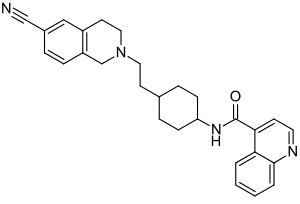SB-277,011-A
SB-277,011A is a drug which acts as a potent and selective dopamine D3 receptor antagonist,[1] which is around 80-100x selective for D3 over D2,[2] and lacks any partial agonist activity.[3]
 | |
| Identifiers | |
|---|---|
IUPAC name
| |
| PubChem CID | |
| IUPHAR/BPS | |
| ChemSpider | |
| ChEMBL | |
| Chemical and physical data | |
| Formula | C28H30N4O |
| Molar mass | 438.563 g/mol g·mol−1 |
| 3D model (JSmol) | |
SMILES
| |
InChI
| |
| | |
SB-277,011A is used in the study of addiction to stimulant drugs such as nicotine[4] and cocaine.[5][6] Where cocaine reduces the threshold for brain electrical self-stimulation in rats, an indication of cocaine's rewarding effects, SB-277,011A completely reverses this effect. It may thus be useful in the treatment of addiction to nicotine and cocaine,[7][8][9] and is also being investigated for potential uses in the treatment of other drug addictions, such as addiction to heroin[10] and alcohol.[11][12][13]
Another potential application for SB-277,011A is in the treatment of schizophrenia,[14] and it may be particularly useful in treating comorbid patients who are both schizophrenic and addicted to drugs.[15] However it may worsen side effects such as tardive dyskinesia in patients who are already prescribed antipsychotic drugs.[16]
References
- Stemp, G; Ashmeade, T; Branch, CL; Hadley, MS; Hunter, AJ; Johnson, CN; Nash, DJ; Thewlis, KM; et al. (2000). "Design and synthesis of trans-N-4-2-(6-cyano-1,2,3, 4-tetrahydroisoquinolin-2-yl)ethylcyclohexyl-4-quinolinecarboxamide (SB-277011): A potent and selective dopamine D(3) receptor antagonist with high oral bioavailability and CNS penetration in the rat". Journal of Medicinal Chemistry. 43 (9): 1878–85. doi:10.1021/jm000090i. PMID 10794704.
- Southam, E; Lloyd, A; Jennings, CA; Cluderay, JE; Cilia, J; Gartlon, JE; Jones, DN (2007). "Effect of the selective dopamine D3 receptor antagonist SB-277011-A on regional c-Fos-like expression in rat forebrain". Brain Research. 1149: 50–7. doi:10.1016/j.brainres.2007.02.051. PMID 17382304.
- Reavill, C; Taylor, SG; Wood, MD; Ashmeade, T; Austin, NE; Avenell, KY; Boyfield, I; Branch, CL; et al. (2000). "Pharmacological actions of a novel, high-affinity, and selective human dopamine D(3) receptor antagonist, SB-277011-A". The Journal of Pharmacology and Experimental Therapeutics. 294 (3): 1154–65. PMID 10945872.
- Le Foll, B; Schwartz, JC; Sokoloff, P (2003). "Disruption of nicotine conditioning by dopamine D(3) receptor ligands". Molecular Psychiatry. 8 (2): 225–30. doi:10.1038/sj.mp.4001202. PMID 12610655.
- Vorel, SR; Ashby Jr, CR; Paul, M; Liu, X; Hayes, R; Hagan, JJ; Middlemiss, DN; Stemp, G; Gardner, EL (2002). "Dopamine D3 receptor antagonism inhibits cocaine-seeking and cocaine-enhanced brain reward in rats". Journal of Neuroscience. 22 (21): 9595–603. doi:10.1523/JNEUROSCI.22-21-09595.2002. PMID 12417684.
- Di Ciano, P; Underwood, RJ; Hagan, JJ; Everitt, BJ (2003). "Attenuation of cue-controlled cocaine-seeking by a selective D3 dopamine receptor antagonist SB-277011-A". Neuropsychopharmacology. 28 (2): 329–38. doi:10.1038/sj.npp.1300148. PMID 12589386.
- Andreoli, M; Tessari, M; Pilla, M; Valerio, E; Hagan, JJ; Heidbreder, CA (2003). "Selective antagonism at dopamine D3 receptors prevents nicotine-triggered relapse to nicotine-seeking behavior". Neuropsychopharmacology. 28 (7): 1272–80. doi:10.1038/sj.npp.1300183. PMID 12700694.
- Ross, JT; Corrigall, WA; Heidbreder, CA; Lesage, MG (2007). "Effects of the selective dopamine D3 receptor antagonist SB-277011A on the reinforcing effects of nicotine as measured by a progressive-ratio schedule in rats". European Journal of Pharmacology. 559 (2–3): 173–9. doi:10.1016/j.ejphar.2007.01.004. PMID 17303116.
- Xi, ZX; Gilbert, J; Campos, AC; Kline, N; Ashby Jr, CR; Hagan, JJ; Heidbreder, CA; Gardner, EL (2004). "Blockade of mesolimbic dopamine D3 receptors inhibits stress-induced reinstatement of cocaine-seeking in rats". Psychopharmacology. 176 (1): 57–65. doi:10.1007/s00213-004-1858-y. PMC 3726040. PMID 15083257.
- Ashby Jr, CR; Paul, M; Gardner, EL; Heidbreder, CA; Hagan, JJ (2003). "Acute administration of the selective D3 receptor antagonist SB-277011A blocks the acquisition and expression of the conditioned place preference response to heroin in male rats". Synapse. 48 (3): 154–6. doi:10.1002/syn.10188. PMID 12645041.
- Thanos, PK; Katana, JM; Ashby Jr, CR; Michaelides, M; Gardner, EL; Heidbreder, CA; Volkow, ND (2005). "The selective dopamine D3 receptor antagonist SB-277011-A attenuates ethanol consumption in ethanol preferring (P) and non-preferring (NP) rats". Pharmacology Biochemistry and Behavior. 81 (1): 190–7. doi:10.1016/j.pbb.2005.03.013. PMID 15894078.
- Vengeliene, V; Leonardi-Essmann, F; Perreau-Lenz, S; Gebicke-Haerter, P; Drescher, K; Gross, G; Spanagel, R (2006). "The dopamine D3 receptor plays an essential role in alcohol-seeking and relapse". The FASEB Journal. 20 (13): 2223–33. doi:10.1096/fj.06-6110com. PMID 17077299.
- Heidbreder, CA; Andreoli, M; Marcon, C; Hutcheson, DM; Gardner, EL; Ashby Jr, CR (2007). "Evidence for the role of dopamine D3 receptors in oral operant alcohol self-administration and reinstatement of alcohol-seeking behavior in mice". Addiction Biology. 12 (1): 35–50. doi:10.1111/j.1369-1600.2007.00051.x. PMID 17407496.
- Joyce, JN; Millan, MJ (2005). "Dopamine D3 receptor antagonists as therapeutic agents". Drug Discovery Today. 10 (13): 917–25. doi:10.1016/S1359-6446(05)03491-4. PMID 15993811.
- Jahnke, U (2008). "Experimental pharmacotherapeutics for schizophrenia and addiction". IDrugs. 11 (1): 7–9. PMID 18175251.
- Malik, P; Andersen, MB; Peacock, L (2004). "The effects of dopamine D3 agonists and antagonists in a nonhuman primate model of tardive dyskinesia". Pharmacology Biochemistry and Behavior. 78 (4): 805–10. doi:10.1016/j.pbb.2004.05.019. PMID 15301939.